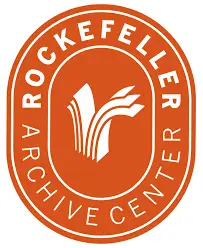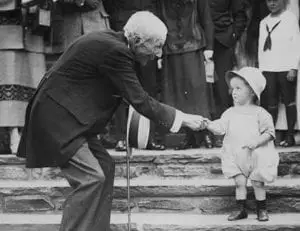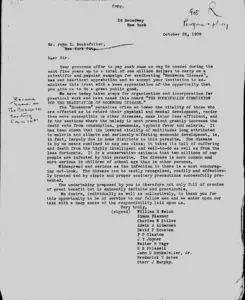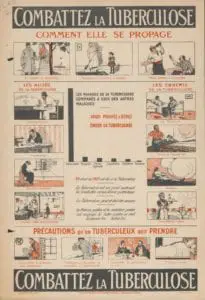Digitizing Scientific Research at The Rockefeller Archive Center

Today, The Rockefeller Archive Center (RAC) is responsible for archiving, preserving and giving access to the Rockefeller story through historical documents and artifacts…good (groundbreaking medical research), bad and potentially ugly (fruit cake from the 1901 wedding of John Rockefeller Jr. and Abby Aldrich Rockefeller). Kanisha Greaves, RAC’s Assistant Archivist/Digitization Project Manager, gave insight into the research bolstered by the famous family, its significance and how the team at the archive is working to digitize collections for future public use with help from The Crowley Company.
The Duality of Rockefeller:
Tycoon and Philanthropist
RAC’s story starts with the many foundations, funds and research organizations that produces its housed collections. There is a deep history of charities and breakthroughs (both famous and infamous) to dip into. The Rockefeller Foundation’s digital history gives a thorough history of its origins and motivation but I will try to summarize.

After founding Standard Oil company in 1870, which once had a monopoly on the petroleum gas business, Rockefeller amassed a massive personal fortune and was considered the richest man on earth by the beginning of the 20th century.
A lifelong Baptist, the tenets of charity had been instilled in Rockefeller, Sr. from a young age and he was known to respond to requests for funds personally. As Rockefeller’s wealth grew, the requests and funds became difficult to manage.
Rather than continue to give to individuals directly, Rockefeller, Sr. – along with Frederick T. Gates and John Rockefeller, Jr. – created a way to give back by conducting research to treat “the ‘root causes’ underlying both physical illness and social problems” through the Rockefeller Institute for Medical Research (1901). The institute was eventually renamed The Rockefeller University and became (and remains) one of the preeminent centers of medical research worldwide, producing such major breakthroughs as:
- Identified the phenomenon of autoimmune disease
- Showed that genes are structurally composed of DNA
- Developed the methadone treatment of heroin addiction
- Devised the AIDS “drug cocktail”
In 1913, The Rockefeller Foundation was created to keep the many Rockefeller charities under one umbrella. Each charity or institution that was established stuck to three major beliefs: Commitment to open-ended scientific research; the idea that research values are universal values; and the conviction that disease is the root of all other ills — physical, economic, mental, moral and social.
Archiving Everything Rockefeller

Greaves explained that in the 1960’s the family paired with the Rockefeller Foundation, Rockefeller Brothers Fund and The Rockefeller University to combine their archives and collections.
In 1971 John D. Rockefeller, Jr.’s widow, Martha Baird Rockefeller, bequeathed her home to the Rockefeller Brothers Fund. The property was given to Rockefeller University who then established the Rockefeller Archive Center in the mansion which was expanded to add three levels of vaults. RAC became an independent operating foundation in 2008.
Today, the RAC is the largest assemblage in the world of the records of American philanthropic institutions. In addition to holding Rockefeller family and philanthropic pages, the archive houses collections from 40 other charitable organizations. The archives contain significant materials related to the histories of science, medicine, public health, religion and social sciences such as the roots of social justice and environmental movements and support for arts/culture initiatives.
Other interesting materials include William O. Inglis’ interview of Rockefeller, Sr. for his never published biography. “It is interesting to read [Rockefeller, Sr.’s] take on certain aspects of his life and career, such as the early history of Standard Oil and his thoughts on Ida Tarbell’s serials and her eventual book, The History of Standard Oil, which would lead to the break-up of Standard Oil,” Greaves remarked.
Scanning Microfilm Research

With extensive records comes complex digitization plans. RAC’s team created a digitization guide in 2017 to outline which scanning projects could be outsourced and which should be captured in-house. In general, paper collections are kept in-house while other larger material collections are outsourced.
Recently, RAC has focused their outsourced digitization efforts on microfilm collections with the goal of creating better access for on and offsite researchers. Three of the oldest collections were chosen first to preserve the content. Collections include:
- Rockefeller Sanitary Commission for the Eradication of Hookworm. Includes documents on education, inspection, law and legislation, hookworm disease and treatment, dispensaries, public health planning, sanitary engineering and state health systems
- Bureau of Social Hygiene Series 3-5. The Bureau’s mission was to study, eradicate and prevent social conditions, crimes and diseases which adversely affect the well-being of society “with special reference to prostitution and the evils associated therewith.” Documents include information about bureau projects on narcotics, social hygiene, juvenile delinquency, criminology and the papers of former bureau director, Leonard V Harrison.
- Laura Spelman Rockefeller Memorial. A memorial to Rockefeller, Sr.’s wife, the program was intended to benefit the welfare of women and children but philanthropy was not easily granted along divisions of age or sex in 1918. The program’s first few years were fluid and funded the areas of leisure, public health and emergency relief. By 1922 the social sciences, welfare, child study, parent education and interracial relations became primary interests of the memorial.
RAC’s Director of Archives, Bob Clark, had previously partnered with The Crowley Company on a successful microfilm project at the Franklin D. Roosevelt Presidential Library. After careful consideration, RAC chose Crowley’s digitization services team to take on the three collections.
The archive’s Collections Management team took a condition report on each roll before packing them to be sent to Crowley’s Frederick, MD services bureau. The 35mm microfilm rolls were then scanned using Mekel Technology MACH-Series scanners and the resulting 100,000 images output as grayscale TIFF images. The images will be added to the Digital Information Management Engine Searching (DIMES) online collection catalog (named after Rockefeller, Sr.’s habit of giving away dimes as a token and conversation starter on the importance of frugality).
In-House Paper Digitization

As per the RAC digitization guide, researcher requests for scanned paper materials are digitized at the folder level rather than scanning the individual page. This allows the archive to simultaneously capture the images for the researcher and for future incorporation into the DIMES catalog. To accommodate the larger volume while ensuring archival image quality, the team purchased a Zeutschel 12000 in 2015 and two zeta overhead scanners in 2016 and 2019. Pre-COVID, the three-person digitization team scans around 63,000 pages a year in-house.
Moving Forward
What’s next for the Rockefeller Archive Center? “Digitizing, digitizing, and more digitizing,” Greaves reports. “COVID has limited the amount of digitizing we are doing at this moment but we are continuing our mission to make more collections accessible to researchers, wherever they may be.”
As the world faces the current health and social crisis, we see firsthand the importance of research and action in creating a safer future. The Rockefeller University has launched studies on the SARS-CoV-2 virus to develop solutions to prevent and treat COVID-19 infections. When the time comes, the information from these studies will be stored in the archive and made accessible on the DIMES catalog. We send our gratitude to those working tirelessly to bring an end to the pandemic and the ever-valuable archives that preserve their achievements.

